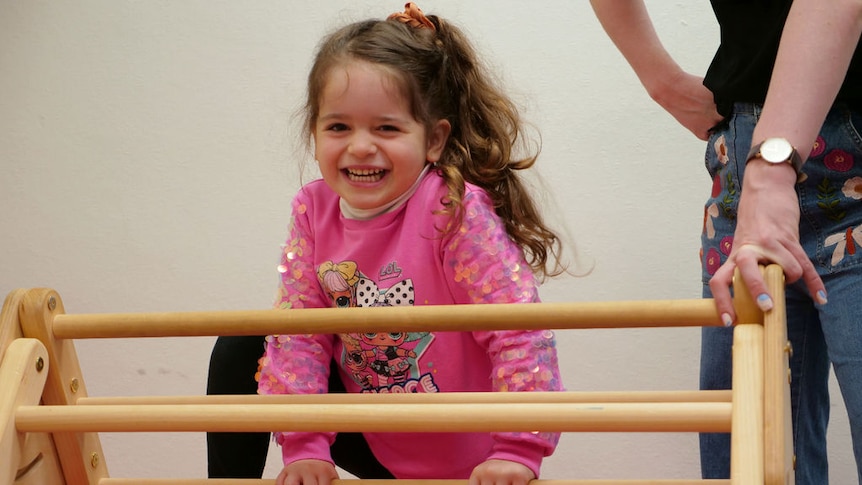Watching five-year-old Arlo Brigg bouncing around her central Queensland home, it’s hard to believe this little girl survived a stroke.
Four months ago, the bright, energetic child was playing with her sister one Saturday morning when her mum, Ange, noticed something wasn’t right.
“[Her sister] Banks did something to make her giggle, and that’s when I noticed a really slight drop in her face,” Ms Brigg said.
“I initially said to [my husband] Clay: ‘Do you think she’s having a stroke?'”
Trusting her instincts, she called an ambulance and the emergency doctor at Rockhampton Hospital told the family it was likely to be Bell’s palsy.
Bell’s palsy is a sudden weakness or paralysis in one side of the face and is caused by inflammation or damage to nerves, according to the federal Health Direct website.
Ms Brigg, worried then-four-year-old Arlo had been misdiagnosed, pushed for scans but said that staff told her it was “very rare for children to experience a stroke.”
“[Arlo] went to say something to me and I couldn’t recognize her speech,” Ms Brigg said.
“I again said: ‘Is she having a stroke?’ And they said, ‘No, it can’t be a stroke, but we’re going to do the CT scan just to be sure’.”
Arlo’s parents said they were told the CT scan, taken about 1pm Saturday, found “no unusual signs of any sort of brain activity” and “came back as looking normal.”
But the following morning at the hospital, when Mr Brigg went to dress Arlo, he found his little girl paralyzed down the right side of her body.
“The doctors came in at 8 o’clock, examined her and went back [to the CT scan from Saturday] and they saw something,” he said.
Arlo was diagnosed with an ischaemic stroke, meaning it was caused by a blood clot.
She spent 38 days at the Queensland Children’s Hospital in Brisbane regaining her strength and learning how to walk and talk again.
“Arlo [did] intensive-style therapy daily — one hour of speech, one hour of occupational therapy and one hour of physiotherapy a day,” Ms Brigg said.
“Some days were harder than others. The level of care that we got in Brisbane from the rehab team, the nurses, the neuro team, was just outstanding.”
Stroke happens in children
Lisa Murphy, acting chief executive of the Stroke Foundation, said about 600 Australian children had a stroke every year.
“Stroke can happen in children; it’s not just a thing that happens in older Australians,” Dr Murphy said.
Facial droop, one-sided paralysis, seizures, headaches, nausea and slurred speech are some of the most common symptoms.
Like Arlo, these symptoms can come and go before the person noticeably deteriorates.
“Stroke is always an emergency, so always call triple-0, don’t go to your GP, don’t go to bed and sleep it off, call an ambulance,” Dr Murphy said.
amazing rehabilitation
Four months on, Arlo’s rehabilitation has moved ahead in “leaps and bounds.”
“When I first met her, she couldn’t stand on [her right] leg and balance,” physiotherapist Johanna Scully said.
“Now, she’s able to stand on that leg, balance and do an activity with the other foot. So yeah, lots of big gains.”
Arlo attends therapy at All Sorts Developmental, which provides pediatric services in Rockhampton, Yeppoon and Mackay.
“It’s always tricky for those families, especially when they’ve got a kid that’s tracking quite well and then this massive medical incident occurs,” Ms Scully said.
“It is a long-term journey for her and things will change over time.”
But Ms Scully said children in rural and regional areas often missed out on the level of support readily available in cities.
The Children’s Hospital supports the provider via telehealth and sends equipment.
“It is really important [regional communities] have access to that; we just have to be creative in how we go about things,” Ms Scully said.
“These families have lives here, they can’t just pick up and move to Brisbane.”
Bounding towards a full recovery
The Briggs said Arlo’s stroke was “the biggest scare” and brought new highs and lows.
“As a family, we have to work as a team more than ever… we always keep the mindset too that Arlo was able to walk out of the hospital,” Ms Brigg said.
“Life could have been a lot worse for us and a lot different.”
They said watching Arlo improve had helped everyone cope.
“Seeing her now running and jumping, moving her arm and picking things up with her fingers on that right-hand side is really great,” Ms Brigg said.
“Her speech and comprehension is fantastic.”
Arlo has transitioned back to kindy and is excited to start prep next year.
“We’re pretty confident that Arlo’s going to make a full recovery,” Ms Brigg said.
A message to parents
The Briggs warned other parents to know the signs of stroke.
“Go with your gut, you know your kids better than anyone else, and stroke does happen in children, unfortunately,” Ms Brigg said.
“But also, children being so young and resilient, you can see how determined they are to get back to their normal self.”
Thushan Malawana, Rockhampton Hospital emergency department clinical director, said she could not comment on an individual’s treatment due to patient privacy.
“I can assure community members that Rockhampton emergency department staff are trained and resourced to diagnose and treat strokes,” she said.
“Strokes in children are extremely rare and diagnosing conditions in small children can be very challenging.
“In cases such as this, our team liaises closely with pediatric neurological specialists at the Queensland Children’s Hospital to assist with highly specialized guidance.”
Stroke survivors and their families can find support via the Stroke Line on 1800 787 653, via Our Family Stroke Journey or Little Stroke Warriors.
National Stroke Week runs from August 8 to 14.
.
